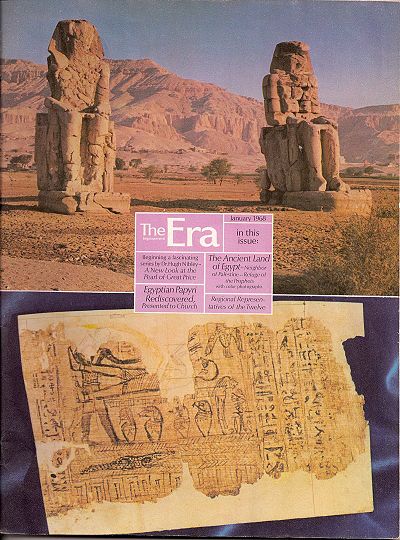
FAIR is a non-profit organization dedicated to providing well-documented answers to criticisms of the doctrine, practice, and history of The Church of Jesus Christ of Latter-day Saints.
| Answers portal |
| The Book of Abraham |
|
FAQ:
Book of Abraham content: Production: |
|
There are a number of criticisms related to the recovered fragments of the Joseph Smith papyri. These criticisms are addressed below.
To see citations to the critical sources for these claims, click here
So let’s start with the relationship of the Book of Abraham to the Joseph Smith Papyri. There are three different points of view here. One, that Joseph Smith translated the Book of Abraham from the papyri that we have. Almost no one really believes this. But to hear the critics tell it this is the official position of the church. It’s not. Nor do most members of the church subscribe to this so far as I can tell. So, it’s a strawman. The second one is that Joseph Smith translated the Book of Abraham from papyri that we do not currently have and this is the position that most accords with the historical evidence. And the third one is that Joseph Smith received the Book of Abraham strictly by revelation and it did not come from the papyri at all. This position seems to be popular among Latter-day Saints but seems to have no historical evidence to support it.
An example of what I am talking about is the recent discovery of the papyrus scrolls from which Joseph Smith was presumed to have translated the book of Abraham in the Pearl of Great Price. Modern scholars, looking at the scrolls, found nothing they considered to be similar to that book. I remarked at the time that such a finding didn't bother me in the least. God doesn't need a crib sheet in the form of a papyrus scroll to reveal Abraham's thoughts and words to Joseph Smith, with any degree of precision He considers necessary for His purposes. If the only function of the scrolls was to awaken the Prophet to the idea of receiving such inspiration, they would have fulfilled their purpose.
—Henry Eyring, Reflections of a Scientist, p. 46
Joseph Smith had in his possession three or four long scrolls, plus a hypocephalus (Facsimile 2). Of these original materials, only a handful of fragments were recovered at the Metropolitan Museum. The majority of the papyri remains lost, and has likely been destroyed. Critics who claim that we have all, or a majority, of the papyri possessed by Joseph Smith are simply mistaken.
The Egyptian characters on the recovered documents are a portion of the "Book of Breathings," an Egyptian religious text buried with mummies that instructed the dead on how to successfully reach the afterlife. This particular Book of Breathings was written for a deceased man named Hor, so it it usually called the Hor Book of Breathings.
Other than the vignette represented in Facsimile 1, the material on the papyri received by the Church, at least from a standard Egyptological point of view, does not include the actual text of the Book of Abraham. This was discussed in the Church publication, the New Era in January 1968.
The following articles explore more detail regarding various aspects of the Book of Abraham.
Summary: Joseph Smith had in his possession three or four long scrolls, plus a hypocephalus (Facsimile 2). Of these original materials, only a handful of fragments were recovered at the Metropolitan Museum. The majority of the papyri remains lost, and has likely been destroyed.

Summary: We do not claim to know why the text of the Book of Abraham (or the missing Book of Joseph) is not in evidence on the fragments of papyrus that were recovered. Critics, of course, simply assume this to be conclusive evidence that Joseph was a fraud. From a believer's perspective, however, there are several possible theories to account for this: 1) The text was revealed much in the same manner as that of the Book of Mormon, without the need for the actual papyri, 2) The text was present on portions of the papyri that are missing, and 3) The Book of Abraham manuscript was attached to the Book of Breathings manuscript and was lost. 4) Perhaps there was a way of understanding the Egyptian ideograms anciently that is unknown to Egyptology in our day, yet to be discovered, deciphered or acknowledged, that could yield an interpretation of a text that is different than the standard Egyptological reading.
Summary: Among the early Book-of-Abraham-related-manuscripts that have survived from the days of Joseph Smith are a number of papers collectively referred to as the "Kirtland Egyptian Papers" (KEP). These pages were written while the Saints lived in Kirtland, Ohio, and were recorded in the general time frame that Joseph was translating the Book of Abraham. They are in the same handwriting of several of Joseph's scribes.
Summary: In the Book of Abraham, Joseph included three facsimiles of illustrations from the papyri, along with commentary about what the images and their individual parts represented. Some of Joseph's interpretations are similar to those of trained Egyptologists, but most are not. A number of criticisms relate to the three facsimiles associated with the Book of Abraham. It is noted that Joseph Smith's translation of the facsimiles does not agree with that provided by Egyptologists, and that some missing portions of the facsimiles were incorrectly restored before they were published.
==
Notes
==

FAIR is a non-profit organization dedicated to providing well-documented answers to criticisms of the doctrine, practice, and history of The Church of Jesus Christ of Latter-day Saints.
We are a volunteer organization. We invite you to give back.
Donate Now